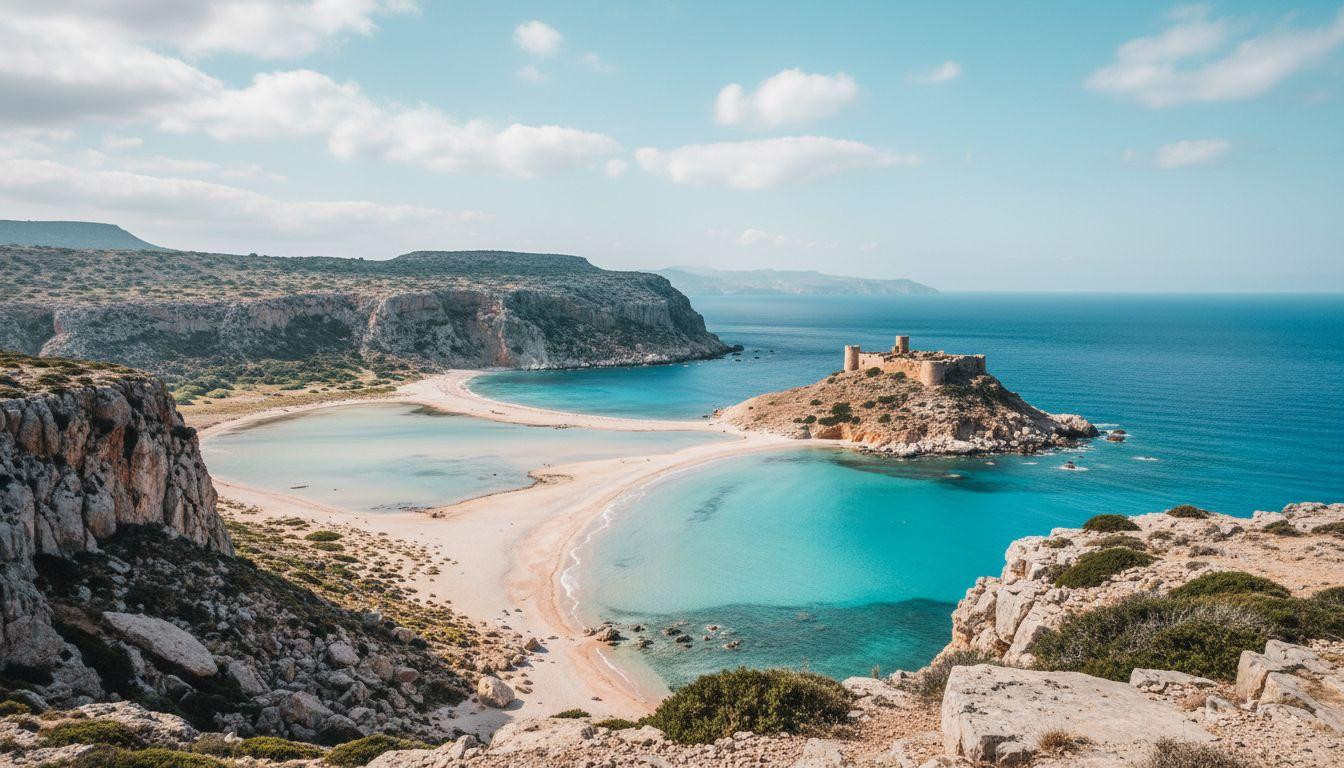This lagoon 35 miles northwest of Chania where pink sand meets turquoise water between 650-foot cliffs delivers the Mediterranean’s most striking visual paradox. Balos Lagoon transforms Caribbean dreams into Greek reality through protected Natura 2000 status and zero entrance fees. Morning light at 6:42 AM reveals waters so clear you count fish from clifftop viewpoints. Steam rises from coffee cups in nearby Kaliviani village while Tigani Island’s Venetian fortress casts shadows across the lagoon below.
Where Crete hides its most dramatic coastline
Balos Lagoon occupies the northwestern extreme of Crete’s Chania Prefecture between the Gramvousa Peninsula and offshore Tigani Island. The lagoon earned protected status within the Natura 2000 network, reflecting ecological significance that keeps development deliberately minimal. Two access routes define the journey to this 35-mile destination from Chania Airport.
The overland approach requires navigating a bumpy gravel road from Kaliviani village followed by a 20-30 minute clifftop descent with 330-foot elevation change. Morning ferries from Kissamos Port offer a relaxing alternative, departing around 10:30 AM for approximately $30 roundtrip. The same golden light that defines Greek island beauty illuminates Balos without Santorini’s premium pricing.
International travelers reach Chania Airport via Athens with one-hour connecting flights. Car rentals for the 35-mile drive to Kissamos cost approximately $45-65 daily. The challenging access preserves what mass tourism destroys: empty beaches at sunrise and cognitive dissonance of Caribbean aesthetics in Mediterranean geography.
The landscape that defies Mediterranean expectations
The impossible color palette
Balos presents visual contradictions that cameras struggle to capture authentically. The lagoon displays hypnotic turquoise waters shifting through multiple blue shades depending on depth and sun angle. The beach features soft white sand tinged with pink, composed partially of crushed Foraminifera shells and coral fragments.
These microscopic organisms create the distinctive coloration through “vivid red and pink shells that grow on dead coral reefs,” according to local marine research. Surrounding landscape provides dramatic contrast through barren, rocky hillsides descending sharply to this water oasis. Locals describe the formation as an “enchanted oasis in barren landscape.”
Historical layers rising from water
Tigani Island dominates the lagoon’s center, accessible by wading through knee-deep water across 650 feet of natural sandbar. The island rises 385 feet, crowned by a preserved Venetian fortress that served as a 19th-century pirate stronghold. Greek island authenticity emerges through medieval chapel ruins dotting the fortress interior.
Historical records indicate up to 3,000 residents inhabited the fortress at peak pirate occupation. The population built a school and church called Panagia i Kleftrina, dedicated to pirates’ wives. North of Balos, at Korykon cape, ruins of the ancient Roman city of Agnion include a temple to Apollo.
What November 2025 reveals about Balos
Morning light magic
Early arrivals before 10 AM discover Balos in its most tranquil state. Morning light enhances pink sand tones while clarity allows visibility deep into the water column. November temperatures hover around 59-63°F with seawater cooling to 63-64°F. The surrounding cliffs create natural windbreaks in protected areas.
Recent visitor surveys conducted in 2025 reveal that early morning visits ensure maximum tranquility and superior photography with fewer people visible in frames. Similar turquoise clarity characterizes protected Mediterranean coves that maintain natural beauty through limited access.
The swimming zones
The central lagoon offers shallow, warm water perfect for families with children. Deeper, cooler sea exists beyond the natural sandbar separating lagoon from open Mediterranean. Snorkeling opportunities concentrate along rocky edges where marine life thrives in crystal-clear conditions.
Visibility extends several meters below surface during calm morning conditions. Local tourism boards confirm that schools of fish dart between swimmers’ feet in water clear enough to observe bottom formations. The lagoon’s protected nature creates calmer waters than exposed Mediterranean beaches.
The practical reality of paradise
Balos charges no entrance fee, representing significant value versus Mediterranean alternatives. Designated parking costs $3-5 daily, supporting beach maintenance and basic facilities. A small kiosk operates during warm months selling beverages for $2-4 and simple meals for $4-8.
All primary activities involve no fees beyond parking: swimming, snorkeling, and hiking around the lagoon. The 20-30 minute descent requires sturdy footwear as terrain becomes rocky and uneven. Dramatic coastal formations reward hikers willing to navigate challenging access routes.
Ascent takes 30-40 minutes, best attempted during cooler morning or late afternoon hours rather than midday heat. Visitors universally bring substantial food given limited kiosk options. Equipment rental through beach vendors costs $5-10 per item daily for snorkels, fins, and umbrellas.
Your Questions About Balos Lagoon Answered
When should I visit Balos?
Late spring through early fall (May-October) represents the optimal window, with May and October offering advantages over peak summer crowds. Official tourism data from 2025 shows early morning visits departing parking areas by 7-8 AM ensure maximum tranquility. November visits appeal to solitude-seekers accepting cooler water temperatures around 63°F.
How does Balos compare to Santorini?
While Santorini charges $330+ nightly for hotels and battles 10,000+ daily summer visitors, Balos delivers comparable Greek island beauty. Accommodation in nearby Kissamos costs $45-90 nightly plus zero lagoon entrance fees. The trade-off requires intentional access through hiking or ferry versus Santorini’s airport convenience.
What makes the sand pink?
The pink tinge results from crushed Foraminifera shells and coral fragments mixing with white sand. These microscopic organisms with bright pink shells create natural composition paralleling Caribbean aesthetic in Mediterranean geography. Marine research confirms thousands of years of erosion produced the distinctive coloration through organic shell breakdown.
As afternoon light gilds Tigani Island’s fortress walls and turquoise water deepens to cobalt, the last wade-explorers cross back to pink sand beaches. Balos guards its secret through deliberate access challenges, authentic zero-cost entry, and impossible beauty that defies Mediterranean expectations between ancient cliffs and crystal waters.
